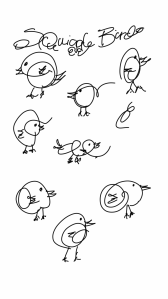Ever since last week’s #PKMChat on microcontent and microlearning (3-18-15) I’ve been thinking in microterms. As I thought more carefully about how I was using microcontent to microlearn this week, I realized that I had learned a few microlessons. This things worth sharing post is themed around these microlessons.
1) How can game design principles help us use smaller slices of information to enhance engagement and learning? Game On! Applying Game Design Principles to research, teaching, and outreach strategies, a conference keynote session I attended by Dr. Rosa Mikeal Martey in 2011, has influenced my thinking about using smaller slices of information to create engaging learning opportunities. With all the conversation on microcontent and microlearning in #PKMChat this week, many insights about microcontent and microlearning can be gained by understanding these gaming design principles, specifically:
- progressive levels – how can we break things into smaller more manageable slices
- feedback and measurement – providing more frequent feedback and measurement to sustain motivation and encourage experimentation
- narrative and purpose – how to connect the smaller slices to a larger purpose
Towards the end of her presentation, Dr. Martey prompts researchers, educators, and outreach professionals to design learning and engagement opportunities (perhaps microlessons?) around the question: “What is it you need to learn?”, rather than “How will I know what you know?”.
2)How about a drawing microchallenge? A couple weeks ago I used Dave Gray’s squiggle bird YouTube video to give myself a two minute drawing microchallenge. Adding feet and tail feathers on a variety of squiggles stretched my idea of what a bird could look like (check out the long little bird in the middle). This microchallenge helped me see how I can make characters out of many other shapes. It also was a great example of microcontent (video) and microlesson (the challenge) which led to my own microlearning (a small step forward in my artistic skill development).
 My attempt at drawing squiggle birds on my phone.
My attempt at drawing squiggle birds on my phone.3)Does microcontent = planned and re-purposed content? I’ve thought of creating better microcontent mostly as the act of re-purposing bits of long form online educational events and content such as webinars, blog posts, or PDFs to share through social media. During a conversation with Helen Blunden during last week’s #PKMChat, I realized I highly value conversation threads as a form of microcontent.
@ActivateLearn I agree. Best microcontent is in the flow of learning & conversation to me. #PKMchat
— Karen Jeannette (@kjeannette) March 18, 2015
This helped remind me to plan to curate or share conversational insights back to the community of learners when appropriate. Storify and RebelMouse (see this EdTechLN example with its e-newsletter feature) are two tools I’ve seen that help to make lighter work out of curating and sharing conversations that make for great microcontent.
4)How do we become designers of better microchoices? Information architect Abbey Covert changed my thinking about who is a designer when I first saw her Slideshare presentation How to Make Sense of Any Mess.
After many years of not completely understanding why I’ve been intrigued by design thinking or why I’ve been completely annoyed by the paradox of choice when I enter the toothpaste aisle or go to buy a pair of jeans, it has become apparent to me that 21st century skills include becoming better at designing solutions and frameworks to make better and many microchoices.
As educational professionals, I see three ways where we can design solutions to help make better microchoices:
- Designing and implementing our own daily (PKM) personal framework and routine to get better at making, articulating, and sharing how we make microchoices in an information abundant and complex world.
- Designing microcontent (or perhaps microlessons) that can help others learn and act to make a microchoice.
- Designing (or co-designing) social learning frameworks or environments that spark opportunities to build knowledge, skills, and on-going social support so people can continue to learn together as knowledge evolves.

I really like the way you are thinking about micro choices and your suggestions for enabling them.
That TED talk about the paradox of choice is really powerful and one of my favorites. – it rings so true for me.
Thanks Kate. It’s helpful to hear that this idea resonates with others too. One of my pain points over the years is reading information and having no better understanding on how to solve a problem/dilemma or get to the next step, so designing content to help people make choices is something I really care about. However, sometimes that is not enough, so, to me, then the next question is – how do we design opportunities to foster other connections and conversations that can help provide the learner/user additional context for making those choices?
Karen, great post! I enjoyed your reflections. – Chris